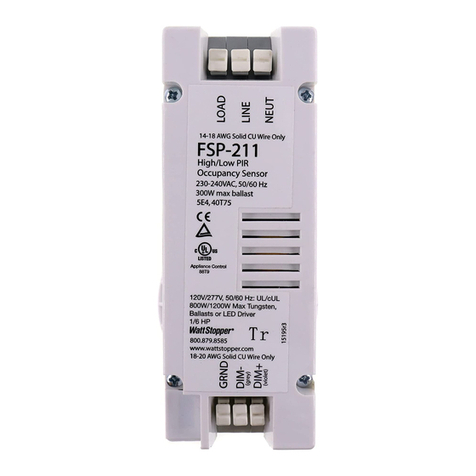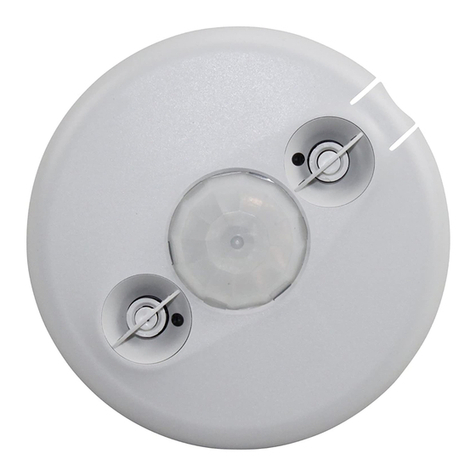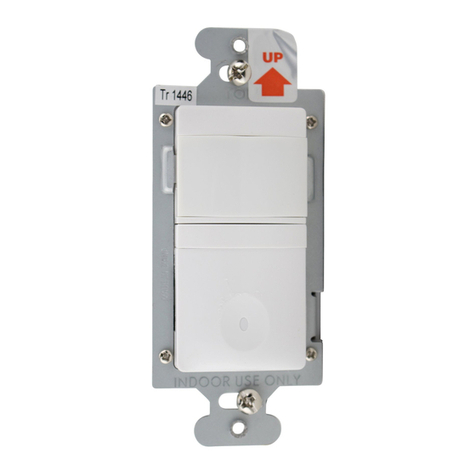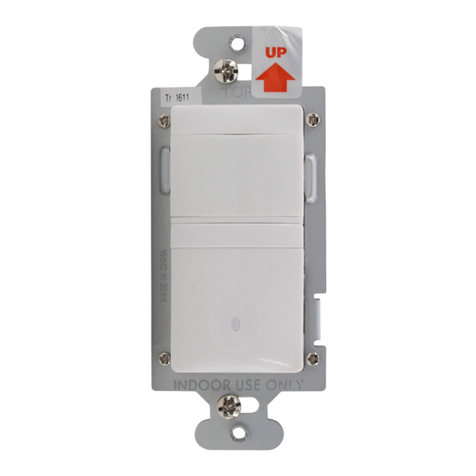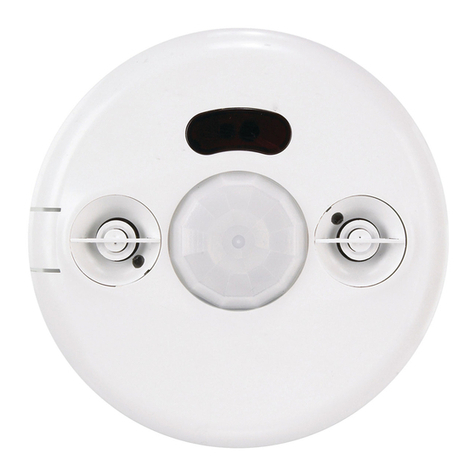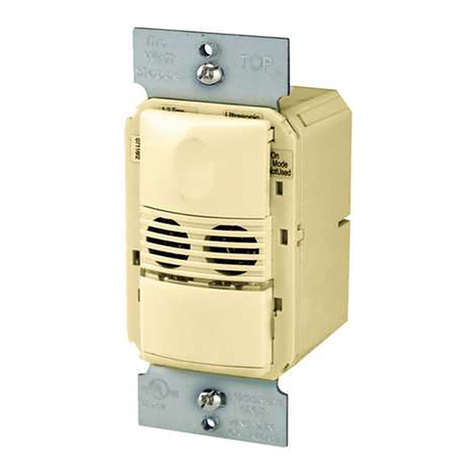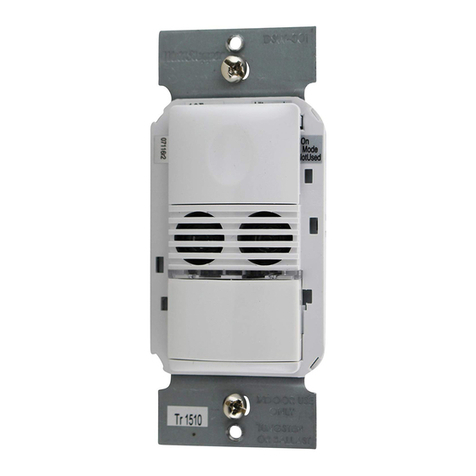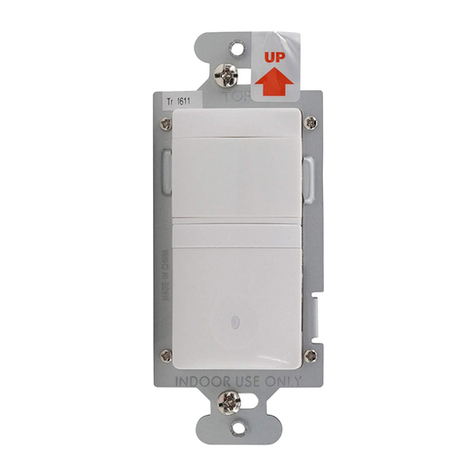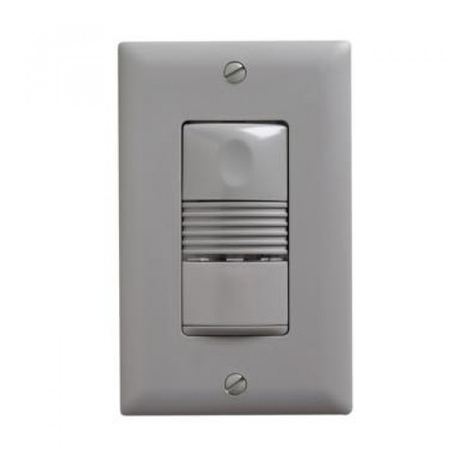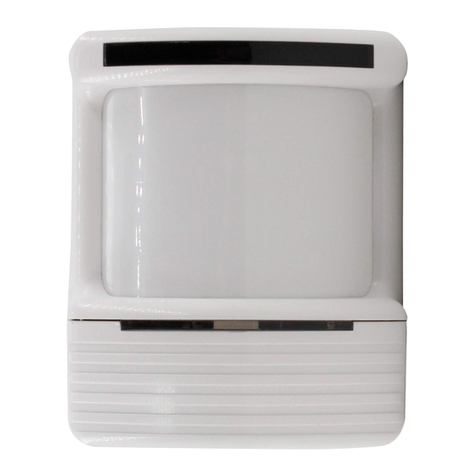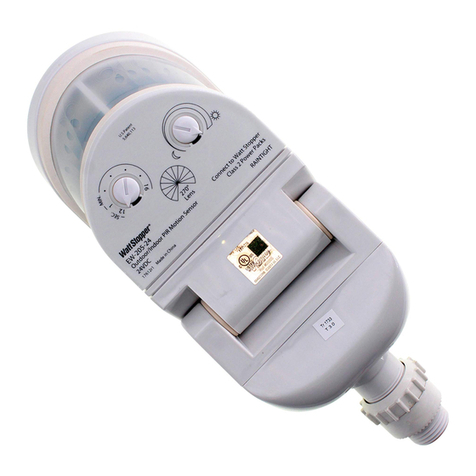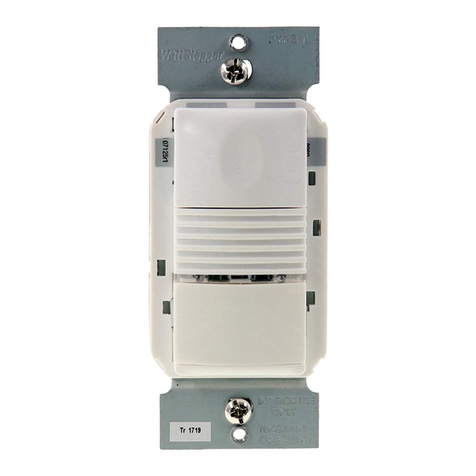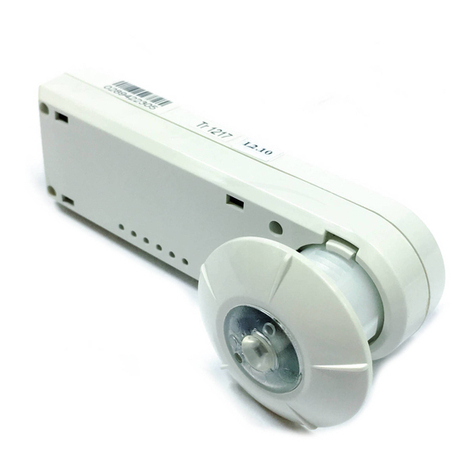
SSENSOR ADJUSTMENT
THE SENSORS ARE FACTORY PRESET*TO ALLOW FOR QUICK INSTALLATION IN
MOST APPLICATIONS. However, verification of proper wiring or coverage, or customizing
of the sensor’s settings can be done through the following steps.
Before starting, make sure the office furniture is installed, lighting circuits are turned on,
and the HVAC systems are in the overridden/on position. VAV systems should be set to
their highest airflow.
There is a warm-up period when power is first
applied to the sensor of up to one and a half
minutes.
1. For testing, set the Time Delay to minimum, 15 seconds.
See chart below for DIP switch configurations.
2. Ensure that the Sensitivity and Light Level trimpots
are set to maximum, fully clockwise.
3. Remain still. The lights should turn off after
approximately 15 seconds (If not, see Troubleshooting).
4. Set the desired Time Delay.
5. Readjust the angle of the sensor if necessary.
Time Delay:
• The Time Delay is set with DIP Switches 1 thru 4.
Light Level feature:
• The Light Level feature holds lights off upon initial
entry into the space if adequate ambient light exists.
It will not turn the lights off if they are on.
• Adjust the Light Level during daylight hours when
ambient light in the area is adequate.
• Avoid mounting the sensor too close to lighting fixtures.
1. Set the Time Delay to minimum, 15 seconds.
2. Set the Light Level trimpot to minimum,
fully counterclockwise.
3. Be still and allow the lights to turn off.
4. Move a hand in front of sensor every 10 seconds (to
keep sensor activated), and without blocking any light
from reaching the sensor, in small increments, turn
Light Level adjustment toward maximum, waiting at
least 5 seconds between increments, until the lights
turn on. Then turn it back slightly. At this setting the
lights will not turn on with occupancy if the ambient
light is above the current level.
5. Set the desired Time Delay.
6. Readjust the angle of the sensor if necessary.
*Time Delay=18 minutes / Sensitivity & Light Level settings=Maximum.
Light Level
Adjustment
LED
Sensitivity
Adjustment
Time-Delay
DIP Switch
on
25431
✆Call (800) 879-8585 For Technical Support ✆
STROUBLESHOOTING
Lights do not turn on with occupancy, and the following condition exists:
• LED does NOT flash:
When power is initially applied to the sensor, there is a warm-up period of up to
60 seconds before the LED is active.
1. Check that the circuit breaker has been turned back on.
2. Check the Sensitivity settings. Increase (clockwise) as needed.
3. Check all sensor and power pack wire connections.
4. Check for 24VDC at sensor (violet and green or gray wires).
- If 24VDC is present, replace the sensor.
- If 24VDC is not present, check that high voltage is present to power pack.
If it is, replace power pack.
• LED does flash:
1. The Light Level setting or the Sensitivity may be set too low.
2. If the sensor’s Light Level feature has been utilized, the lights connected to the Light
Level Output might be held off because of the level of ambient light in the
controlled area.
- To test whether the Light Level adjustment is the problem, cover the PIR lens
with your hand for 5 seconds to see if the lights turn on, or turn the Light Level
adjustment toward maximum (clockwise). If the lights turn on, the Light Level
setting was keeping the lights off.
• Increase the Light Level setting slightly or follow the procedures under
“Sensor Adjustment” to adjust the Light Level setting.
- The Sensitivity adjustment should be set to maximum, unless a decrease is made
due to an “Unwanted Sensor Activations” adjustment.
3. Check all sensor and power pack wire connections.
4. Check for 24VDC at the power pack’s blue wire connection to sensor while
someone moves in front of sensor to activate the LED. If there is no voltage,
replace the sensor. If there is voltage, replace the power pack.
≠CAUTION≠
TURN POWER OFF AT THE CIRCUIT BREAKER
BEFORE WORKING WITH OR NEAR HIGH VOLTAGE.
Check Our Web Site For FAQs: www.wattstopper.com
Lights do not turn off automatically:
1. The sensor may be experiencing activations from outside the controlled area or
from some type of interference (see “Unwanted Sensor Activations” next page).
2. Check all sensor and power pack wire connections.
3. Disconnect power pack’s blue wire:
If the lights do not turn off, replace power pack. Reconnect blue wire.
If the lights turn off, the problem may be in the sensor—to check:
- Reconnect the blue wire.
- Turn sensitivity and time delay to minimum and allow the sensor to time out.
If the lights turn off, the sensor is working properly (see number 1., above, and
“Sensor Adjustment” for readjustment of sensor).
Unwanted Sensor Activations (LED flashes):
• Possible causes
1. Improper sensor location or angle adjustment causing detection outside of desired
coverage area.
2. Sensitivity set too high.
3. Sensor located too close to HVAC or VAV vents with heavy air flow.
• Possible solutions
1. Mask the lens to reduce PIR coverage (see “Masking the lens”, under “Coverage
Patterns”).
2. Reduce the sensitivity (counterclockwise) as needed (see “Sensor Adjustment”).
3. Adjust the sensor angle (see “Sensor Adjustment”).
4. Relocate the sensor.
Override:
To override all sensor functions, set DIP switch #5 to on.
This bypasses the occupancy and light level control functions of the sensor, but still allows
the lights to be manually controlled with a light switch.
SORDERING INFORMATION
A277E-P
A347D-P
CX-100-3 Occupancy Sensor, Two-Sided Aisleway Lens
MB-1 Industrial Mount Bracket
Power Pack: 277VAC, 60Hz, 20A ballast, 100mA
Power Pack: 347VAC, 60Hz, 15A ballast, 100mA
CX-100
CX-100-1
Occupancy Sensor, Dense Wide Angle Lens (Std)
Occupancy Sensor, Long Range Lens
CX-100-4 Occupancy Sensor, One-Sided Aisleway Lens
A120E-P Power Pack: 120VAC, 60Hz, 100mA
20A ballast/13A incandescent
B230E-P Power Pack: 230VAC, 50/60Hz, 150mA
20A ballast/13A incandescent
B120E-P Power Pack: 120VAC, 60Hz, 150mA
20A ballast/13A incandescent
B347D-P
S120/277/347E-P
Power Pack: 347VAC, 60Hz, 15A ballast, 150mA
B277E-P Power Pack: 277VAC, 60Hz, 20A ballast, 150mA
Slave Pack: 120/277VAC, 60Hz, 20A ballast
347VAC, 60Hz, 15A ballast
Putting a Stop to Energy Waste®
Santa Clara CA 95050 1(800)879-8585 1(972)578-1699
70-0004-00 4/98
SWARRANTY INFORMATION
The Watt Stopper, Inc. warranties its products to be free of defects in materials and
workmanship for a period of five years. There are no obligations or liabilities on the part of
The Watt Stopper, Inc. for consequential damages arising out of or in connection with the
use or performance of this product or other indirect damages with respect to loss of
property, revenue, or profit, or cost of removal, installation or reinstallation.
Installation Instructions
CX-100
PIR Occupancy Sensor
Santa Clara, CA 95050
1(800) 879-8585 1(972)578-1699
www.wattstopper.com
U.S.Patent:
4,787,722
SSPECIFICATIONS
Voltage . . . . . . . . . . . . . . . . . . . . . . . . . . . . . . . . . . . . . . . . . . . . . 24VDC
Current Consumption . . . . . . . . . . . . . . . . . . . . . . . . . . . . . . . . . . 19mA*
Power Supply . . . . . . . . . . . . . . . . . . . . . . . . . . Watt Stopper Power Pack
B series power packs supply power for up to 6 CX-100 sensors
A series power packs supply power for up to 3 CX-100 sensors
Isolated Relay Rating . . . . . . . . . . . . . . . . . . . . . . . . . . . . . . . 1A@24VDC
Time Adjustment . . . . . . . . . . . . . . . . . . . . . . . . . 15 seconds–30 minutes
Sensitivity Adjustment . . . . . . . . . . . . . . . . . . . . . . . . Minimum–Maximum
Light Level Adjustment . . . . . . . . . . . . . . . . . . . . . . . . . . . . . . . . 3–200FC
*Current consumption can be slightly higher when only one sensor per power pack is used.
✆Call (800) 879-8585 For Technical Support ✆
All sensors are white.
15 seconds
4 minutes
6 minutes
8 minutes
10 minutes
12 minutes
14 minutes
2 minutes
16 minutes
20 minutes
22 minutes
24 minutes
26 minutes
28 minutes
30 minutes
Override
18 minutes
12345
DIP Switch #
Time Delays
